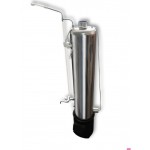
How a Home Autoclave Works
A home autoclave is a special device for food preservation. It greatly simplifies the process of preparing winter preserves, saving time and money. An autoclave can become a great ally for the modern homemaker and handles even large quantities effectively.
Preparation for Canning
First of all, decide on the dish and whether the products are suitable for autoclaving. Choose tested recipes and fresh ingredients. Thoroughly wash the jars, place the products, water, and seal them tightly with metal lids.
Place the jars with the prepared products on racks inside the autoclave. This can be done in several layers, depending on the volume and size of the appliance.
Next, pour water until it covers the jars by 2 cm. Then close the appliance's lid and tighten the nuts or screws.
Principle of Operation
Understanding how an autoclave works is straightforward. It is a small device with sensors, buttons, and a control unit. After purchasing, it's important to carefully read the instructions to avoid mistakes.
The principle of an autoclave is simple. It heats the product to over 100 degrees Celsius. At this temperature, viruses, bacteria, and other harmful elements are killed. It is quite difficult to eliminate even dormant viruses without an autoclave. Ordinary boiling is not sufficient; a higher temperature is needed. Using an autoclave ensures the safety of any preserves, including meat and fish.
Typically, at 100 degrees Celsius, water boils and heating stops. However, if the pressure is increased, the boiling point shifts to higher values. This results in faster cooking, with sterilization lasting only a few tens of minutes. Using an autoclave requires minimal intervention compared to traditional methods.
The pressure inside the autoclave is created because the device is airtight and not connected to the atmosphere. Inside are jars with food, and water is added up to the top edge of the tank. After heating to 90 degrees Celsius, water starts to evaporate gradually. Steam essentially acts as a gas that expands and creates the pressure that prevents further water evaporation. As a result, the boiling temperature increases. When the device is turned off, the steam condenses, and the pressure decreases.
Tip: Canning with an autoclave typically takes 1-2 hours. To save time, do this after lunch. By evening, the preserves will be ready; they can be left to cool overnight before removing the jars. To avoid breaking the appliance or disrupting its functions, do not deviate from the operating principle. Always follow the instructions and adhere to safety guidelines.
Jars should be sealed in advance to create additional airtightness. Inside each jar, pressure is created. Leave an air gap in the containers to compensate for the thermal expansion of the product. Due to the internal pressure, the lids on the jars stay in place.
During the operation of the autoclave, use the manometer and thermometer to monitor the condition of the appliance. If you become distracted and forget, the safety valve will activate. It will release excess pressure and protect the device and its contents.
Cooking time depends on the products. For instance, meat cooks for at least 30 minutes, vegetables for 10 minutes, and mushrooms for 20 minutes. Study this before using the autoclave to avoid ruining the preserves.
When the autoclave's cooking time is up, it's time to remove the jars. This can only be done after cooling to 30-40 degrees Celsius, so that the pressure inside the container equals atmospheric pressure. Remove excess pressure using the nipple. Do not rapidly release air from the appliance.
Read also:
- Autoclave Operating Modes
- What is an Autoclave
- Hydraulic Testing of Autoclaves
- How to Use an Autoclave
- How to Choose an Autoclave









